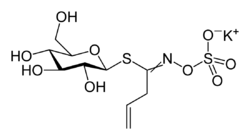Sinigrin
 | |
 | |
| Names | |
|---|---|
| IUPAC name
potassium [(E)-1-[(2S,3R,4S,5S,6R)-3,4,5-trihydroxy-6-(hydroxymethyl)oxan-2-yl]sulfanylbut-3-enylideneamino] sulfate | |
| Identifiers | |
| 3952-98-5 | |
| ChEBI | CHEBI:79317 |
| Jmol-3D images | Image |
| MeSH | Sinigrin |
| PubChem | 23682211 |
| |
| Properties | |
| C10H16KNO9S2 | |
| Molar mass | 397.46 g/mol |
| Except where noted otherwise, data is given for materials in their standard state (at 25 °C (77 °F), 100 kPa) | |
| | |
| Infobox references | |
Sinigrin is a glucosinolate that belongs to the family of glucosides found in some plants of the Brassicaceae family such as Brussels sprouts, broccoli, and the seeds of black mustard (Brassica nigra) to name but a few. Whenever sinigrin-containing plant tissue is crushed or otherwise damaged, the enzyme myrosinase degrades sinigrin to a mustard oil (allyl isothiocyanate), which is responsible for the pungent taste of mustard and horseradish.[1] Seeds of white mustard, Sinapis alba, will give a much less pungent mustard because this species contains a different glucosinolate, sinalbin.
The chemical name of sinigrin is allylglucosinolate or 2-propenylglucosinolate.
Singrin is also known to be allelopathic (Lankau 2008).
See also
References
- ↑ Richard, H. "Arômes alimentaires" (PDF) (in French).
Lankau R. 2008. A chemical trait creates a genetic trade-off between intra- and interspecific competitive ability. Eco. 89(5): 1181-1187.
External links
- "Institute of Food Research". Why your best friend could be a Brassica. Retrieved 2006-01-21.
- Norwich Research Park website
| ||||||||||||||||||||||||||||||||||||||||||||